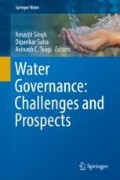Abstract
For nearly seven decades, the Government of India and many state governments have invested in large amounts in the irrigation sector. It is estimated that about INR 4820 billion has been spent to create an irrigation potential of 42 million hectares through major and medium irrigation (Irrigation projects are classified based on culturable command area (CCA) as major having CCA more than 10,000 hectare (ha), medium having CCA between 2000 and 10,000 ha, and minor having CCA less than 2000 ha.). And nearly one and half times of that amount is required to develop the remaining potential during the next quarter century. Such a scale of investment is not possible to be catered based on conventional investment and implementation modalities alone but would need active participation and collaboration of various stakeholders, including users, private sectors, and financial institutions.
Academic literature presents limited evidence of engaging with private sector as most initiatives are for improving efficiency and service improvements. Direct capital investment and maintaining an asset for a long period of time would need to be supported with appropriate revenue mechanisms. Involvement of other stakeholders, notably the private sector, does not have a long precedence in irrigation and drainage sector world over and particularly in India. Past experiences and learnings indicate that there is a lack of robust revenue model and conducive framework to enable better participation. All the revenue models envisage collecting monies from user charges. Given the nature of holdings, societal structures and political and institutional setups, ability to pay higher user charges is limited in India. As an illustration, a viability (financial) analysis has been undertaken to estimate the extent of user fees required to fully pay for an irrigation project. Also an assessment is done to see if any ancillary revenues would help in alleviating the user charges needed. Suggestions for developing an equitable water pricing mechanism from various studies are consolidated and presented.
Access this chapter
Tax calculation will be finalised at checkout
Purchases are for personal use only
Notes
- 1.
International Bank for Reconstruction and Development.
- 2.
Japan International Cooperation Agency.
- 3.
Deutsche Gesellschaft fur Internationale Zusammenarbeit GmbH (German aid agency).
- 4.
Source: 12th Five Year Plan (2012–2017) – Faster, More Inclusive and Sustainable Growth, Planning commission, Government of India.
- 5.
It is weighted average of the user charges set by the concerned government agency for different crops for this particular project.
- 6.
Based on estimation for another major irrigation project.
References
Ahmadi SAY (2015) Design and evaluation of irrigation water pricing policies for enhanced water use efficiency. J Water Res Plan Manag 142:5001–5011
Dinar YT (1997) The relative efficiency and implementation costs of alternative methods for pricing irrigation water. World Bank Econ Rev, 11(2), 243–262. FAO’S AQUASTAT data. Available at: http://www.fao.org/nr/water/aquastat/main/index.stm
Government of India (2013) Planning commission, twelfth five year plan (2012–2017) – faster, more inclusive and sustainable growth
Government of India (2014) Central ground water board, ground water year book of 2014. Available at: www.cgwb.gov.in
Government of India (2015) Central water commission water and related statistics 2015
Hellegers PJGJ, Perry CP (2007) Water pricing in Haryana, India. In: Berkoff FM (ed) Irrigation water pricing. CAB International, pp 192–207
Koppen TS (2006) Is India ripe for integrated water resources management? Fitting water policy to national. Econ Polit Wkly 41(31):3413–3421
Kulkarni SA (2007) Volumetric pricing of irrigation water in India: experiences and lessons learned. In: International Commission on Irrigation and Drainage (ICID), New Delhi
More DM (2016) Traditional water management practices of Maharashtra, President, Maharashtra Irrigation Collaboration, paper presented during India Irrigation Forum, New Delhi
Planning Commission, Government of India (1992) Pricing of irrigation water. New Delhi
Rao KP (1991) On irrigation water pricing in India. Int J Water Resour Dev:274–280
Sampath RK (1992) Issues in irrigation pricing in developing countries. World Dev 20(7):967–977
Sangal SP (1991) Pricing of irrigation waters in India. Economic & Political Weekly
Varma HK, Raghu RS, Dhingra DTV, Amarjit S (2010) Exploring public private partnership in the irrigation sector in India, Asian Development Bank 2012 water pricing and allocation. International Water Management Institute (IWMI)
Venkateswarlu B, Prasad JVNS (2012) Carrying capacity of Indian agriculture: issues related to rain fed agriculture. Central Research Institute for Dryland Agriculture, Hyderabad
Wichelns D (2010) Agricultural water pricing: United States. Indiana: Organisation for Economic Co-operation and Development
William EK (2005) Cost recovery and water pricing for irrigation and drainage projects. The International Bank for Reconstruction and Development/The World Bank, Washington, DC
Acknowledgments
This work is based on a study carried out by Asian Development Bank (ADB). The authors extend thanks to Shri H Verma and other colleagues in ADB during preparation of this manuscript.
Author information
Authors and Affiliations
Corresponding author
Editor information
Editors and Affiliations
Rights and permissions
Copyright information
© 2019 Springer Nature Singapore Pte Ltd.
About this chapter
Cite this chapter
Raghu Rama Swamy, D.T.V. (2019). Financing Aspects of Sustainable Water Management in India. In: Singh, A., Saha, D., Tyagi, A. (eds) Water Governance: Challenges and Prospects. Springer Water. Springer, Singapore. https://doi.org/10.1007/978-981-13-2700-1_17
Download citation
DOI: https://doi.org/10.1007/978-981-13-2700-1_17
Published:
Publisher Name: Springer, Singapore
Print ISBN: 978-981-13-2699-8
Online ISBN: 978-981-13-2700-1
eBook Packages: Earth and Environmental ScienceEarth and Environmental Science (R0)

